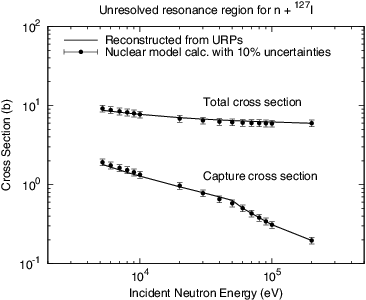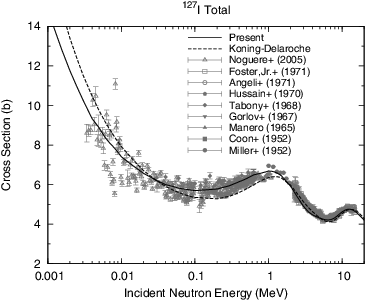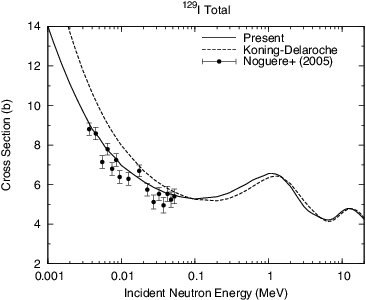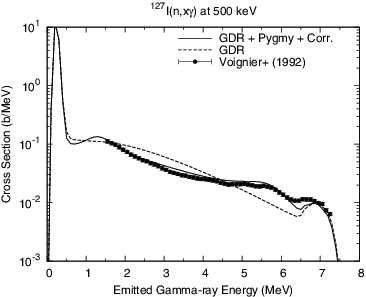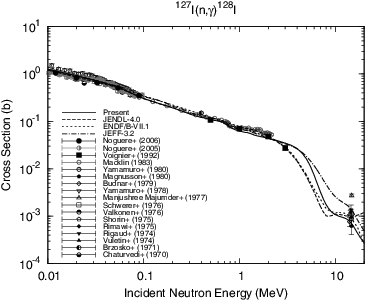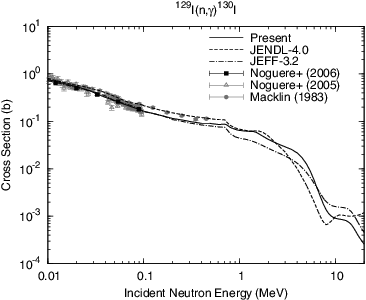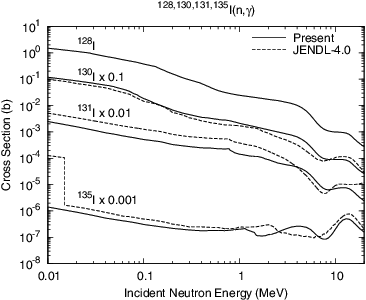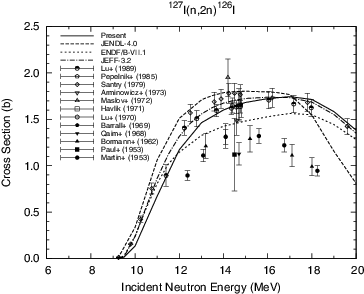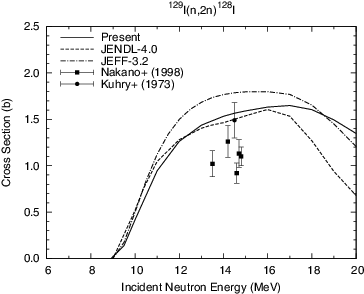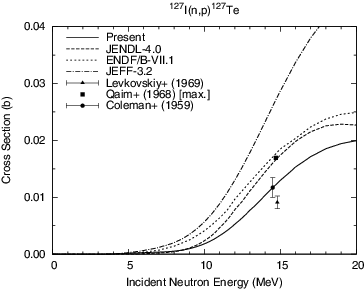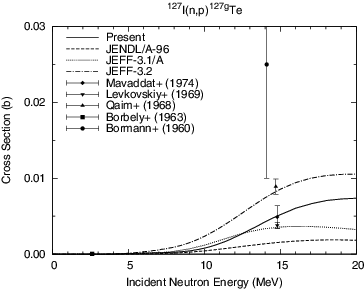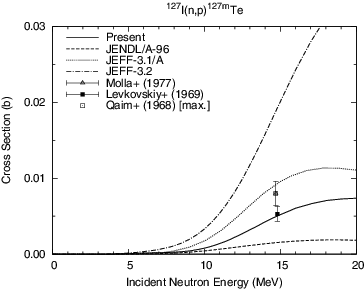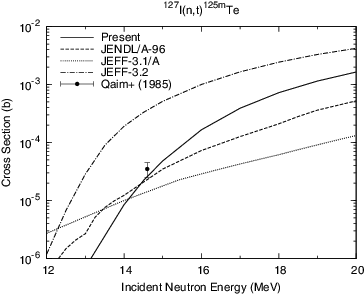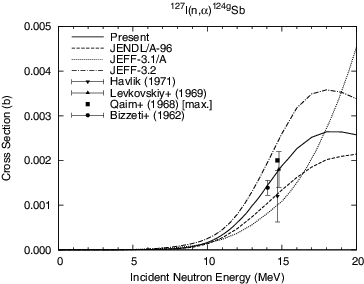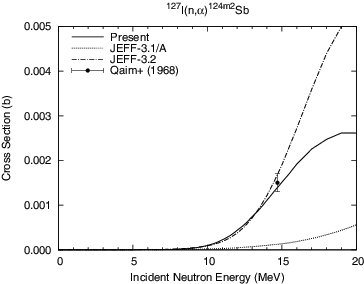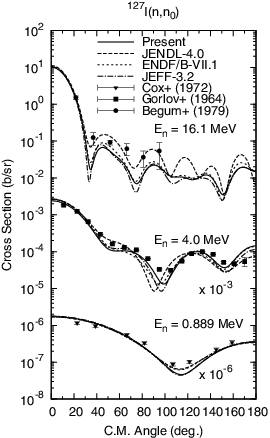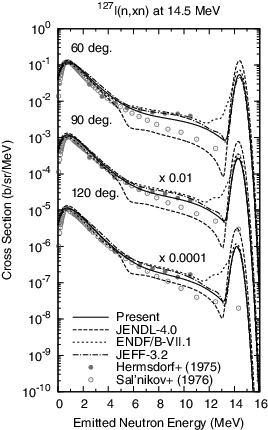 ?Mathematical formulae have been encoded as MathML and are displayed in this HTML version using MathJax in order to improve their display. Uncheck the box to turn MathJax off. This feature requires Javascript. Click on a formula to zoom.
?Mathematical formulae have been encoded as MathML and are displayed in this HTML version using MathJax in order to improve their display. Uncheck the box to turn MathJax off. This feature requires Javascript. Click on a formula to zoom.Abstract
Neutron nuclear data on six isotopes of iodine have been evaluated for the next version of Japanese Evaluated Nuclear Data Library (JENDL) general-purpose file in the energy region from 10−5 eV to 20 MeV. Unresolved resonance parameters were obtained by fitting to the total and capture cross sections calculated from nuclear models, while resolved resonance parameters remain unchanged from JENDL-4.0. A statistical model code was applied to evaluate the cross sections above the resolved resonance region. Coupled-channel optical model parameters were employed for the interaction between neutrons and nuclei. Compound, pre-equilibrium and direct-reaction processes were considered for cross-section calculation in high-energy region. Giant-dipole resonance parameters for γ-ray transition from iodine isotopes were determined so as to reproduce measured γ-ray spectrum for 127I. The present results reproduce experimental data very well. The evaluated data are compiled into ENDF-formatted data files.
1. Introduction
The fourth version of the Japanese Evaluated Nuclear Data Library (JENDL-4.0 [Citation1]) was released in May 2010. In this library, 215 nuclides are regarded as fission products in the region of Z = 30–68. Although the resolved resonance parameters (RRPs) were examined by reviewing experimental data for all of these nuclides, the fast-neutron region above resolved resonances was re-evaluated for about 170 nuclides due to the deadline of the release. Hence, the fast-neutron cross sections for the rest of the fission-product nuclides may need improvements for the next version of JENDL general-purpose file. Under such circumstances, re-evaluations have been actually performed for the data on Er [Citation2], Ga [Citation3], Ru [Citation4], Sb [Citation5] and Te [Citation6], after the release of JENDL-4.0. Iodine is the next target to be dealt with. Moreover, neutron-induced activation cross sections of iodine isotopes are important [Citation7] for the decommissioning of light-water reactors.
The data of 127, 129I were evaluated for JENDL-2 [Citation8] in 1984. For JENDL-3.1 [Citation9], the data on 127, 129I were completely modified and those on 131I were newly evaluated in 1990. After that, these isotopic data were essentially carried over to JENDL-3.2 [Citation10] and JENDL-3.3 [Citation11]. In JENDL-4.0, the data on 130, 135I were added to the library and the RRPs of 127, 129I were renewed. Except for 130, 135I in JENDL-4.0, no γ-ray production data were evaluated. The direct-reaction process, which is important for the inelastic scattering, was not considered in either evaluation.
The present work was undertaken to improve the evaluated data on iodine isotopes by considering the latest knowledge on experimental and theoretical nuclear physics. Moreover, the data on 128I were newly evaluated, since the (n, γ) reaction on 128I yields a long-life (T1/2 = 1.57×107 y) nucleus 129I. The total, elastic and inelastic scattering, (n, γ), (n, p), (n, d), (n, t), (n, 3He), (n, α), (n, np), (n, nd), (n, nα), (n, 2n), (n, 3n), (n, 2np) reaction cross sections, the angular distributions of elastically and inelastically scattered neutrons, and the energy distributions of emitted particles and γ-rays in the energy region from 10−5 eV to 20 MeV are evaluated. The Q-values of the reactions were calculated from the 2012 version of the mass table (AME2012 [Citation12]), and are listed in , together with abundance and half-lives [Citation13]. The RRPs of 127, 129I remain unchanged from JENDL-4.0. The unresolved resonance parameters (URPs) were obtained by fitting to the calculated total and (n, γ) cross sections.
Table 1. Isotopic abundance and reaction Q-values of iodine isotopes.
This paper presents how the evaluation was performed. Section 2 deals with the resonance region. In Section 3, the computational methods and procedures above the resonance region are described. Comparisons of the evaluated results with experimental and existing evaluated data are made in Section 4. Finally, Section 5 summarises the conclusion.
2. Resonance region
The resolved and unresolved resonance regions are given in for each target nucleus. No RRPs are available for 128, 130, 131, 135I. The RRPs of 127, 129I remain unchanged from JENDL-4.0, since the JENDL-4.0 evaluation was based on the data obtained by Noguere et al. [Citation14] and no newer measurements have been made available. Concerning 128, 130, 131, 135I for which RRPs are unavailable, constant and 1/v energy dependencies are assumed for the elastic scattering and capture cross sections, respectively, up to the lower limit of unresolved resonance region. Normalisation of cross sections is done at thermal energy. The thermal scattering cross sections were calculated as 4πR2, where R stands for the scattering radius that can be estimated from nuclear model calculations in the higher energy region. On the other hand, the thermal capture cross sections of these nuclides were estimated by using the simplified formula [Citation5]. This formula gives rough estimates of thermal capture cross sections by using theoretical s-wave γ-ray strength functions. It is used only when no other options are available. The thermal capture and elastic scattering cross sections are listed in , together with the JENDL-4.0 data and the values recommended by Mughabghab [Citation15]. There is a large difference in the capture cross sections of 135I between the present and JENDL-4.0 evaluations. For 135I, the JENDL-4.0 evaluation obviously adopted the same value that was recommended [Citation15] for 131I. The s-wave level spacing of the compound nucleus 136I is theoretically much larger than that of 132I, because the separation energy of a neutron from 136I (3.828 MeV) is considerably smaller than that from 132I (6.332 MeV). Moreover, using the thermodynamical approach [Citation16], the s-wave total radiative width for 136I is found to be 36% smaller than that for 132I. Thus, the capture cross section of 135I is unlikely to be the same for 131I. However, it is not possible to judge which evaluation is reasonable, since no measurements are available.
Table 2. Resolved and unresolved resonance regions.
Table 3. Thermal capture (C) and elastic scattering (E) cross sections at 300 K in units of barns.
The ASREP code [Citation17] was used to determine the URPs by fitting to the total and capture cross sections calculated in the energy region above 10 eV. It should be remarked that the URPs obtained are used only for self-shielding calculations, since the pointwise cross sections are given in the evaluated data files. As an example, the cross sections of 127I reconstructed from the URPs presently obtained are compared with the total and capture cross sections calculated from the nuclear models in . In the parameter fitting, 10% uncertainties in the nuclear model calculations were assumed. It is found from the figure that the reconstructed cross sections reproduce the nuclear model calculations very well.
3. Computational methods and procedures above resonance region
3.1. Nuclear models
The CCONE code (Version 0.8.4) [Citation18] was used for calculating the neutron-induced-reaction cross sections of iodine isotopes. The code is based on the spherical and coupled-channel optical models, the two- component exciton pre-equilibrium model, the distorted-wave Born approximation (DWBA) and the multi-step statistical model. In order to simulate the direct and semi-direct effects on the radiative capture reaction, the pre-equilibrium capture was considered by using the γ-ray emission rate of Akkermans and Gruppelaar [Citation19] extended [Citation18] to the two-component exciton pre-equilibrium model.
3.2. Parameter determination
3.2.1. Optical-model potentials
As for neutrons, we employed the global optical-model parameters obtained by Kunieda et al. [Citation20] using the coupled-channel method based on the rigid rotor model [Citation21]. The potential V(r) is defined as
(1)
(1) where L and σ are the orbital angular momentum and the Pauli matrix, respectively. The form factor fi(r) is of a Woods– Saxon shape, i.e.,
(2)
(2) where Ri is written as
(3)
(3) The angle θ refers to the body-fixed system, and Y0l and βl denote spherical harmonics and a deformation parameter, respectively. The potential depths are given as follows:
(4)
(4)
(5)
(5)
(6)
(6)
(7)
(7)
(8)
(8) where Z, A and N are the atomic number and mass number of a target and N = A − Z, respectively. The symbol E† is the incident-neutron energy (E) relative to the Fermi one (Ef), i.e, E† = E − Ef. The Fermi energy Ef is calculated from neutron-separation energies of target and compound nuclei such as Ef = −{(Sn(Z, A) + Sn(Z, A + 1)}/2. From the neutron potentials, transmission coefficients are obtained together with total cross sections, shape-elastic scattering cross sections and the direct-reaction components of inelastic scattering cross sections for the CCONE calculation.
The parameters required in Equations (Equation2(2)
(2) )–(Equation8
(8)
(8) ) are listed in , and the coupling schemes and deformation parameters are given in . The deformation parameters were originally taken from the work of Koura et al. [Citation22]. The calculated total cross sections of 127I and 129I are shown in and , respectively, together with the experimental data and the spherical optical-model calculations using the parameters of Koning and Delaroche [Citation23]. In order to give a better fit to experimental data, the values of
,
and WIDV were adjusted together with the β2 values for 127, 129I, while the rest of the parameters remain unchanged from the original ones [Citation20]. Concerning charged particles, the spherical parameters of Koning and Delaroche [Citation23] for protons, those of Lohr and Haeberli [Citation24] for deuterons, those of Becchetti and Greenlees [Citation25] for tritons and 3He, and those of Lemos [Citation26] modified by Arthur and Young [Citation27] for α-particles were used. The transmission coefficients, which are required by CCONE to calculate charged-particle emission, are obtained from the charged-particle parameters.
Table 4. Optical-model parameters for neutrons.
Table 5. Coupling schemes used in the interaction between neutron and target.
3.2.2. Discrete levels and level density
In the calculation, it was necessary to input the discrete levels and level-density parameters for 32 nuclei, i.e., 125 − 136I, 125 − 131, 133 − 135Te and 123 − 129, 131 − 133Sb. The discrete levels were taken from the reference input parameters library RIPL-3 [Citation28].
Concerning the level density, the composite formula of Gilbert and Cameron [Citation29] was used in the present work. In the region of low excitation energy E, the level density is described by the constant temperature formula ρT, namely,
(9)
(9) On the other hand, the a parameter, which characterises the Fermi-gas part of level density ρF, is defined as
(10)
(10) where Esh is the shell-correction energy and γ a damping factor. The damping factor is given by γ = 0.40
. The energy U is expressed by E and the pairing energy Δ, i.e., U = E − Δ. In the above equations, the values of a(*) and Δ were taken from the work of Mengoni and Nakajima [Citation30]. The shell-correction energy Esh is calculated as the difference between the experimental mass [Citation12] and the theoretical mass [Citation31]. The two parameters T and E0 were determined so as to connect ρF and ρT smoothly at an appropriate matching energy Em. The parameters used in this work are listed in for individual nuclei, together with the energies of the highest discrete levels
.
Table 6. Level density parameters for each nucleus.
3.2.3. Gamma-ray transition
The γ-ray transmission coefficients are related to the photoabsorption cross sections by the detailed balance. The photoabsorption cross section is usually approximated by various Lorentzian shapes. In the present calculation, the shape was determined by comparing with the gamma-ray spectra measured by Voignier et al. [Citation32] at 500 keV. Three terms were needed to reproduce the spectra, i.e., a giant-dipole resonance (GDR), a pygmy resonance and a correction term, as in the analysis performed by Kim et al. [Citation33]. A generalised Lorentzian (GLO), which was proposed by Kopecky and Uhl [Citation34], was used for the GDR and the pygmy resonance, while the correction term was based on a standard Lorentzian (SLO). The resonance energy (E0), resonance width (Γ0) and peak cross section (σ0) were fixed for all iodine isotopes, and they are given in . The calculated γ-ray spectrum is compared with the data measured by Voignier et al. at an angle of 90° in , where the measurements are multiplied by 4π. When the three terms mentioned above are considered, agreement between the calculation and the experiment is satisfactory. For other nuclei, the GDR parameters for GLO are given [Citation35] by
(11)
(11)
(12)
(12)
(13)
(13) The SLO form was used to describe the M1 and E2 radiations for which the parameters were taken from the work of Kopecky and Uhl [Citation34].
Table 7. E1 parameters for iodine isotopes.
In cases where the measured capture cross sections are available, the γ-ray strength functions are renormalised so that the calculated cross sections reproduce these data. The s-wave γ-ray strength functions are compared in with the values recommended by Mughabghab [Citation15] and those used in the JENDL-4.0 evaluation. The values of 128, 130I were obtained after renormalisation using measurements.
Table 8. Gamma-ray strength functions for s-wave neutron in units of 10−4.
3.2.4. Pre-equilibrium parameters
The Version 0.8.4 of CCONE incorporates pre-equilibrium process for the (n, γ) and first-step binary reactions such as (n, n′), (n, p), (n, d), (n, t), (n, 3He) and (n, α). In the two-exciton pre-equilibrium formalism, the single-particle state densities for protons and neutrons in a residual nucleus are described [Citation36] by
(14)
(14)
(15)
(15) respectively. The parameter C0, of which the default value is unity, is changed so that the calculations reproduce measured neutron and proton emission data such as (n, 2n) and (n, p) in the present work. The (n, 2n) reaction is a ternary reaction, which proceeds from (n, n′) by sequential decay in the framework of the multi-step statistical model. Hence, the (n, 2n) cross section is sensitive to C0 for the residual nucleus in the (n, n′) reaction. More experimental data are available for (n, 2n) than for (n, n′) in the nuclides presently concerned. In addition to the C0’s, the pre-equilibrium parameters for complex-particle emission [Citation37] were determined, i.e., those for the deuteron pickup reaction from the 127I(n, t) reaction and those for the 3He pickup and the α knockout reactions from the 127I(n, α) reaction. These parameters for the complex particles were used for all iodine targets. The pre-equilibrium parameters used are listed in , where C0’s are given only for the residual nuclei in the (n, n′) and (n, p) reactions, and are assumed to be unity for those in the other first-step binary reactions.
Table 9. Pre-equilibrium parameters.
4. Comparison with experimental data and other evaluated data in the fast-neutron energy region
Comparisons are made with experimental data and other evaluated data. The experimental data are taken from the EXFOR database [Citation38] that is compiled by the intentional data centres such as the IAEA Nuclear Data Section, the OECD NEA Data Bank and the National Nuclear Data Center at the Brookhaven National Laboratory. As for the general-purpose evaluated nuclear data, there exist three major libraries, namely JENDL-4.0 [Citation1], ENDF/B-VII.1 [Citation39] and JEFF-3.2 [Citation40]. However, the fast-neutron cross sections of 129, 131I in ENDF/B-VII.1 were actually taken from JENDL-3.3, which means that these data are almost the same as those in JENDL-4.0. Moreover, the 131I data in JEFF-3.2 are equivalent to those in JENDL-4.0. Identical evaluated data are not drawn in the following figures. Except 127, 128, 129I in JEFF-3.2, the general-purpose libraries do not contain activation cross sections leading to the ground or isomeric state. The activation cross-section files JENDL/A-96 [Citation41] and JEFF-3.1/A [Citation42] are used for comparison with such activation data. We do not discuss most of the reactions where experimental data are unavailable, since it is difficult to judge whether the present evaluation is reasonable without measurements.
Capture cross sections of 127I and 129I are illustrated in and , respectively. As for 127I, all the evaluations are in agreement with one another below several MeV. In the energy region from 500 keV to 3 MeV, the present evaluation is almost consistent with the data measured by Voignier et al. [Citation32], while the measurements of Macklin [Citation43], which the JENDL-4.0 evaluation was based on, are somewhat larger than the present values. In the case of 129I, the present and JEFF-3.2 evaluations are smaller than the data measured by Macklin [Citation43] between 30 and 500 keV. The 129I data of JENDL-4.0 were normalised to the data of Macklin around 100 keV, and therefore, they are larger than the other evaluations in the 30–500 keV region. In either isotope, the present results agree very well with the measurements of Noguere et al. [Citation14,Citation44] below 100 keV. Although experimental data are unavailable for the capture cross sections of the remaining isotopes, they are shown in , where the JENDL-4.0 cross sections are also indicated for 130, 131, 135I. As for 135I, the fast-neutron cross sections of JENDL-4.0 were connected at 15 keV with the 1/v cross sections having a big thermal value of 80.03 b, as seen from .
shows the (n, 2n) reaction cross sections of 127I. There exist many experiments for 127I. However, the data are divided into two groups, i.e., lower cross-section group and the higher one. Most of the evaluations, except ENDF/B-VII.1, belong to the higher group. The present evaluation is consistent with the data measured by Lu et al. [Citation45,Citation46]. The JENDL-4.0 evaluation rapidly decreases above 17 MeV. This can be explained by too large (n, 3n) cross section as seen in , although the other evaluations are consistent with one another. Only two experimental data-sets are available for 129I, as shown in . The latest measurements of Nakano et al. [Citation47] are smaller than all of the evaluations. The present evaluation, as well as JENDL-4.0, obviously places emphasis on the data measured by Kuhry and Bontems [Citation48] by considering the result for 127I.
Charged-particle emission cross sections of 127I are illustrated in –. The measured (n, p) cross sections are well reproduced by the present evaluation. It is found from and that the isomeric-state production of JEFF-3.2 is obviously overestimated. The ground-state production cross section measured by Bormann et al. [Citation49] is larger than all of the evaluations, although their experimental uncertainties are also large. A single measurement [Citation50] is available for the (n, t) reaction. In the present work, the pre-equilibrium parameter for triton emission was adjusted so as to reproduce it. There exist two measurements for the 127I(n, α)124m2Sb reaction, i.e., 18.4 ± 2.8 mb at 14.5 MeV measured by Paul and Clarke [Citation51], and 1.5 ± 0.2 mb at 14.7 MeV measured by Qaim and Ejaz [Citation52]. The present evaluation is based on the latter measurement, since the measured ground-state and isomeric-state production cross sections should be reproduced simultaneously.
Angular distributions of neutrons elastically scattered from 127I are shown in . The experimental data of Gorlov et al. [Citation53] and Cox and Cox [Citation54] were corrected for the neutrons inelastically scattered from low-lying levels of 127I, while such a correction was not made in the data of Begum et al. [Citation55]. At an incident energy of 16.1 MeV, all the evaluations, except JENDL-4.0, are lower than the data measured by Begum et al. in the region from 40° to 90°. Even if the inelastic scattering is taken into account in the present evaluation, the resultant distributions are found to be somewhat smaller than the measurements. As a matter of fact, the angular distributions, which Begum et al. measured for several medium and heavy nuclei at 16.1 MeV, were found to be mostly larger than the optical-model predictions at angles ≥ 40°. More experiments would be needed to clarify the differences above an incident energy of 10 MeV.
Double-differential neutron emission spectra at 14.5 MeV are illustrated in . The present evaluation as well as ENDF/B-VII.1 and JEFF-3.2 is almost consistent with the data measured by Hermsdorf et al. [Citation56], whereas the three evaluations deviate from the data of Sal’nikov et al. [Citation57] with the increasing emitted-neutron energy. On the other hand, the JENDL-4.0 evaluation seems lower than the measurements above 6 MeV, although there is a systematic difference in the measured data in the high-energy region. In JENDL-4.0, the pre-equilibrium enhancement was considered for the normalised continuous (n,n’) spectra, which are the neutrons inelastically scattered from the overlapping levels of 127I. However, their absolute cross sections were not enhanced by the pre-equilibrium effect. In fact, the 14-MeV continuous (n,n’) cross section of JENDL-4.0 amounts to 118 mb, while those for other libraries exceed 400 mb. Therefore, the underestimate of JENDL-4.0 is due to the contradictory treatment of the pre-equilibrium process in the evaluation.
5. Concluding remarks
The neutron nuclear data on iodine isotopes were evaluated in the energy region from 10−5 eV to 20 MeV. The RRPs of 127, 129I remain unchanged from JENDL-4.0. In the low-energy region, the 1/v behaviour was assumed for the capture cross sections of 128, 130, 131, 135I, and the thermal cross sections were normalised to the values calculated from the simplified formula. The URPs were obtained for self-shielding calculations by fitting to the total and capture cross sections calculated from the nuclear models.
In the present work, the statistical-model code CCONE was applied to the calculation of fast-neutron cross sections. The neutron transmission coefficients were obtained by the coupled-channel method, together with the total cross sections, the shape-elastic scattering cross sections and the direct-reaction components of the inelastic scattering cross sections. The neutron potentials were found to be reliable by comparing with the measured total cross sections. The GDR parameters for iodine isotopes, which were needed to calculate γ-ray emission, were determined so as to reproduce the γ-ray spectrum for 127I measured at 500 keV. On the whole, the presently evaluated cross sections are in good agreement with measurements. The data on 128I, which were missing in JENDL-4.0, were newly evaluated. Moreover, γ-ray production data were evaluated for all nuclides, while these data were given only for 130, 135I in JENDL-4.0. The evaluated data are compiled into ENDF-formatted data files for the next release of JENDL general-purpose file.
Acknowledgements
The author would like to thank the members of the Nuclear Data Center, Japan Atomic Energy Agency, for their helpful comments on this work.
References
- Shibata K, Iwamoto O, Nakagawa T, Iwamoto N, Ichihara A, Kunieda S, Chiba S, Furutaka K, Otuka N, Ohsawa T, Murata T, Matsunobu H, Zukeran A, Kamada S, Katakura J. JENDL-4.0: a new library for nuclear science and engineering. J Nucl Sci Technol. 2011; 48: 1–30.
- Shibata K. Evaluation of neutron nuclear data for erbium. J Nucl Sci Technol. 2012; 49: 824–835.
- Shibata K. Evaluation of neutron nuclear data for gallium. J Nucl Sci Technol. 2013; 50: 277–286.
- Shibata K. Evaluation of neutron nuclear data on ruthenium isotopes. J Nucl Sci Technol. 2013; 50: 1177–1187.
- Shibata K. Evaluation of neutron nuclear data on antimony isotopes. J Nucl Sci Technol. 2014; 51: 425–436.
- Shibata K. Evaluation of neutron nuclear data on tellurium isotopes. To be published in J Nucl Sci Technol. doi:10.1080/00223131.2014.956157
- IAEA Safety Standards Series. Application of the concepts of exclusion, exemption and clearance (No. RS-G-1.7). Vienna: International Atomic Energy Agency; 2004.
- Kikuchi Y, Nakagawa T, Asami T, Kawai M, Matsunobu H, Kanda Y. Second version of Japanese evaluated nuclear data library (JENDL-2). J Nucl Sci Technol. 1985; 22: 593–603.
- Asami T, Iijima S, Igarasi S, Ihara H, Kawai M, Kikuchi Y, Komuro Y, Shibata K, Takano H, Takeda T, Nakagawa T, Nakazawa M, Hasegawa A, Maekawa H, Mizumoto M, Yoshida T. [Japanese evaluated nuclear data library version 3, JENDL-3]. J At Energy Soc Jpn. 1989;31:1190–1217. Japanese.
- Nakagawa T, Shibata K, Chiba S, Fukahori T, Nakajima Y, Kikuchi Y, Kawano T, Kanda Y, Ohsawa T, Matsunobu H, Kawai M, Zukeran A, Watanabe T, Igarasi S, Kosako K, Asami T. Japanese evaluated nuclear data library version 3 revision-2: JENDL-3.2. J Nucl Sci Technol. 1995; 32: 1259–1271.
- Shibata K, Kawano T, Nakagawa T, Iwamoto O, Katakura J, Fukahori T, Chiba S, Hasegawa A, Murata T, Matsunobu H, Ohsawa T, Nakajima Y, Yoshida T, Zukeran A, Kawai M, Baba M, Ishikawa M, Asami T, Watanabe T, Watanabe Y, Igashira M, Yamamuro N, Kitazawa H, Yamano N, Takano H. Japanese evaluated nuclear data library version 3 revision-3: JENDL-3.3. J Nucl Sci Technol. 2002; 39: 1125–1136.
- Wang M, Audi G, Wapstra AH, Kondev FG, MacCormick M, Xu X, Pfeiffer B. The AME2012 atomic mass evaluation (II). Tables, graphs and references. Chinese Phys C. 2012; 36: 1603–2014.
- Tuli JK. Nuclear wallet cards. 8th ed. Upton, NY: Brookhaven National Laboratory; 2011.
- Noguere G, Bouland O, Brusegan A, Schillebeeckx P, Siegler P, Leprêtre A, Herault, Rudolf G. Neutron capture and total cross sections of 127I and 129I. Phys Rev C. 2006; 74: 054602.
- Mughabghab SF. Atlas of neutron resonances, resonance parameters and thermal cross section Z=1–100. Amsterdam: Elsevier; 2006.
- Benzi V, Maino G, Menapace E, Ventura A. BCS level density calculations and consistent estimate of radiative widths by means of a thermodynamic model. In: Coceva C, Panini GC, editors. Proceedings of Specialists’ Meeting on Neutron Cross Sections of Fission Product Nuclei; 1979 December 12–14; Bologna. Bologna: Comitato Nazionale Energia Nucleare; 1979. p. 215–230.
- Kikuchi Y, Nakagawa T, Nakajima Y. [ASREP: a computer program for automatic search of unresolved resonance parameters (JAERI-Data/Code 99-025)]. Tokai: Japan Atomic Energy Research Institute; 1999. Japanese.
- Iwamoto O. Development of a comprehensive code for nuclear data evaluation, CCONE, and validation using neutron-induced cross sections for uranium isotopes. J Nucl Sci Technol. 2007; 44: 687–697.
- Akkermans JM, Gruppelaar H. Analysis of continuum gamma-ray emission in precompound-decay reactions. Phys Lett B. 1985; 157: 95–100.
- Kunieda S, Chiba S, Shibata K, Ichihara A, Sukhovitskiĩ ESh. Coupled-channels optical model analyses of nucleon-induced reactions for medium and heavy nuclei in the energy region from 1 keV to 200 MeV. J Nucl Sci Technol. 2007; 44: 838–852.
- Tamura T. Analyses of the scattering of nuclear particles by collective nuclei in terms of the coupled-channel calculation. Rev Mod Phys. 1965; 37: 679–708.
- Koura H, Tachibana T, Uno M., Yamada M. Nuclidic mass formula on a spherical basis with an improved even-odd term. Prog Theor Phys. 2005; 113: 305–325.
- Koning AJ, Delaroche JP. Local and global nucleon optical models from 1 keV to 200 MeV. Nucl Phys A. 2003; 713: 231–310.
- Lohr JM, Haeberli W. Elastic scattering of 9–13 MeV vector polarized deuterons. Nucl Phys A. 1974; 232: 381–397.
- Becchetti FD, Greenlees GW. A general set of 3He and triton optical-model potentials for A > 40, E < 40 MeV. In: Barshall HH, Haeberli W, editors. Proceedings of the Third International Symposium on Polarization Phenomena in Nuclear Reactions; 1970 August 31–September 4. Madison (WI): University of Wisconsin Press; 1971. p. 682–683.
- Lomos OF. [Elastic scattering of alpha-particles from 21 to 29.6 MeV in the nuclide region of Ti–Zn] [dissertation]. Los Alamos (NM): Université de Paris-sud; 1972. French. (Orsay report, Series A., No. 136).
- Arthur ED, Young PG. Evaluated neutron-induced cross sections for 54, 56Fe to 40 MeV (LA-8626-MS). Los Alamos (NM): Los Alamos National Laboratory; 1980.
- Capote R, Herman M, Obložinský P, Young PG, Goriely S, Belgaya T, Ignatyuk AV, Koning AJ, Hilaire S, Plujko VA, Avrigeanu M, Bersillon O, Chadwick M, Fukahori T, Ge Z, Han Y, Kailas S, Kopecky J, Maslov VM, Reffo G, Sin M, Soukhovitskii ESh, Talou P. RIPL–reference input parameter library for calculations of nuclear reactions and nuclear data evaluations. Nucl Data Sheets. 2009; 110: 3107–3214.
- Gilbert A, Cameron AGW. A composite nuclear-level density formula with shell corrections. Can J Phys. 1965; 43: 1446–1496.
- Mengoni A, Nakajima Y. Fermi-gas model parametrization of nuclear level density. J Nucl Sci Technol. 1994; 31: 151–162.
- Myers WD, Swiatecki WJ. Nuclear masses and deformations. Nucl Phys. 1966; 81: 1–60.
- Voignier J, Joly S, Grenier G. Capture cross sections and gamma-ray spectra from the interaction of 0.5- to 3.0-MeV neutrons with nuclei in the mass range A = 45 to 238. Nucl Sci Eng. 1992; 112: 87–94.
- Kim HI, Yi MJ, Lee YO. Evaluation of neutron capture gamma-ray spectra for 89Y, 93Nb, 127I, 133Cs, 141Pr, 197Au, natTl, and 209Bi. J Nucl Sci Technol. 2007; 44: 1117–1125.
- Kopecky J, Uhl M. Test of gamma-ray strength functions in nuclear reaction model calculations. Phys Rev C. 1990; 41: 1941–1955.
- Kopecky J. Gamma-ray strength functions (IAEA-TECDOC-1034). Vienna: International Atomic Energy Agency; 1998.
- Koning AJ, Duijvestijn MC. A global pre-equilibrium analysis from 7 to 200 MeV based on the optical model potential. Nucl Phys A. 2004; 744: 15–76.
- Kalbach C. The Griffin model, complex particles and direct reactions. Z Phys A. 1977; 283: 401–411.
- Schwerer O, editor. EXFOR formats description for users (EXFOR basics)(IAEA-NDS-206). Vienna: International Atomic Energy Agency; 2008.
- Chadwick MB, Herman M, Obložinský P, Dunn ME, Danon Y, Kahler AC, Smith DL, Pritychenko B, Arbanas G, Arcilla R, Brewer R, Brown DA, Capote R, Carlson AD, Cho YS, Derrien H, Guber K, Hale GM, Hoblit S, Holloway S, Johnson TD, Kawano T, Kiedrowski BC, Kim H, Kunieda S, Larson NM, Leal L, Lestone JP, Little RC, McCutchan EA, MacFarlane RE, MacInnes M, Mattoon CM, McKnight RD, Mughabghab SF, Nobre GPA, Palmiotti G, Palumbo A, Pigni MT, Pronyaev VG, Sayer RO, Sonzogni AA, Summers NC, Talou P, Thompson IJ, Trkov A, Vogt RL, van der Marck SC, Wallner A, White MC, Wiarda D, Young PG. ENDF/B-VII.1 nuclear data for science and technology: cross sections, covariances, fission product yields and decay data. Nucl Data Sheets. 2011; 112: 2887–2996.
- OECD Nuclear Energy Agency Data Bank. Available from http://www.oecd-nea.org/dbforms/data/eva/ evatapes/jeff_32/
- Nakajima Y. JENDL activation cross section file. In: Igashira M, Nakagawa T, editors. Proceedings of the 1990 Symposium on Nuclear Data (JAERI-M 91-032); 1990 November 29–30; Tokai. Tokai; Japan Atomic Energy Research Institute; 1991, p. 43–57.
- Koning A, Forrest R, Kellet M, Mills R, Henriksson H, Rugama Y, editors. The JEFF-3.1 nuclear data library. Paris: OECD Nuclear Energy Agency; 2006. (JEFF Report 21).
- Macklin RL. Neutron capture cross sections and resonances of iodine-127 and iodine-129. Nucl Sci Eng. 1983; 85: 350–361.
- Noguère G, Brusegan A, Leprêtre A, Herault N, Bouland O, Rudolf G. Reich-Moore analysis of the 127I and 129I resolved resonance range. In: Haight RC, Chadwick MB, Kawano T, Talou P, editors. Proceedings of the International Conference on Nuclear Data for Science and Technology; 2004 September 26–October 1. Santa Fe (NM): American Institute of Physics; 2005. p. 1462–1465.
- Lu HL, Wang DH, Xia YJ, Cui YF, Chen PL. [Excitation curves for some reactions of Al, Ti, V and I]. High Energy Phys Nucl Phys China. 1979;3:88–96. Chinese.
- Zhao WR, Lu HL, Yu WX, Yuan XL. Compilation of measurements and evaluations of nuclear activation cross sections for nuclear data applications. Vienna: International Atomic Energy Agency; 1989. (INDC(CPR)-16).
- Nakano D, Murata I, Takahashi A. Measurement of reaction cross sections of fission products induced by DT neutrons. In: Yoshida T, Fukahori T, editors. Proceedings of the 1997 Symposium on Nuclear Data; 1997 November 27–28. Tokai: Japan Atomic Energy Research Institute; 1998, p. 210–214.
- Kuhry JG, Bontems G. Période de 129I et section efficace de la réaction 129I/n,2n/128I pour des neutrons de 14.5 MeV. Radiochem Radioanal Lett. 1973; 15: 29–32.
- Bormann VM, Jeremie H, Anderson-Lindström G, Neuert H, Pollehn H. [Cross sections for 14 MeV neutrons in the scintillation crystals NaI(Tl), KI(Tl), CsI(Tl) and Li6I(Eu) component nuclear reactions]. Z Naturforsch A. 1960;15:200–210. German.
- Qaim SM. Isomeric cross-section ratios in (n, t) reactions on some medium- and heavy-mass nuclei at 14.6 MeV. Nucl Phys A. 1985; 438: 384–394.
- Paul EB, Clarke RL. Cross-section measurements of reactions induced by neutrons of 14.5 MeV energy. Can J Phys. 1953; 31: 267–277.
- Qaim SM, Ejaz M. Half-lives and activation cross-sections of some radio-isotopes of iodine, tellurium and antimony formed in the interactions of iodine with 14.7 MeV neutrons. J Inorg Nucl Chem. 1968; 30: 2577–2581.
- Gorlov GV, Lebedeva NS, Morozov VM. [Elastic scattering of polarized neutrons by Be9, C12, Co59, Ni62, Se80, Nb93, Cd114, In115, Sn118, I127, Pb, and Bi209 nuclei]. Dokl Akad Nauk USSR. 1964;158:574–577. Russian.
- Cox SA, Cox EED. Polarization in the elastic scattering of neutrons from medium- and heavy-weight elements. Argonne: Argonne National Laboratory; 1972. (ANL-7935).
- Begum A, Galloway RB, McNeil-Watson FK. The polarization of 16 MeV neutrons due to elastic scattering by C, Fe, Cu, I, W, Hg and Pb. Nucl Phys A. 1979; 332: 349–364.
- Hermsdorf D, Meister A, Sassonoff S, Seeliger D, Seidel K, Shahin F. [Differential neutron emission cross sections σnM(E0; E, θ) at 14.6 MeV for the elements Be, C, Na, Mg, Al, Si, P, S, Ca, Ti, V, Cr, Mn, Fe, Co, Ni, Cu, Zn, Ga, Se, Br, Zr, Nb, Cd, In, Sn, Sb, I, Ta, W, Au, Hg, Pb and Bi]. Dresden: Zentralinstitut für Kernforschung Rossendorf; 1975. German. (ZfK-277 (Ü)).
- Sal’nikov OA, Anufriehko VB, Devkin BV, Kotel’nikova GV, Lovchikova GN, Trufanov AM, Fetisov NI. [Neutron inelastic scattering on iodine and antimony nuclei]. Yadernye Konstanty. 1976;23:6–10. Russian.

